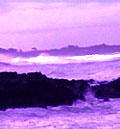
| Home |
(with optional keyboard, guitar, cello) This piece was premiered by the composer,
Janet Dunbar, as soprano, and Richard Holmes as performance poet at
the Fifth International New Music Festival in San Diego on Saturday,
April 10, 1999. This piece is the last in a series of aural environments for Jacqueline Thurston's mixed media photography and poetry installation. For this particular project, there are five sections of poetic text which are to be dramatically read over taped collages of sampled environmental sounds and algorithmically-generated sections coded with Common Music (an extension of Common Lisp). These recited sections are referred to heretofore as Ir-Vr. Interspersed between these sections of performance poetry with taped backgrounds, each portion of text is also set for soprano over piano or synthesizer, electric or acoustic guitar and celleto or cello. These sung sections are referred to heretofore as Is-Vs. The form for the full version of the piece is thus: Ir-Is-IIr-IIs-IIIr-IIIs-IVr-IVs-Vr-Vs. The instrumentation for accompanying the singing voice may be either acoustic or electronic, depending on the musicians' preference. However, if any of the instruments chosen is electronic, then any acoustic instruments as well as the singing voice would need to be amplified for appropriate balancing and blending of their respective sonorities. The piece is designed specifically to allow it to be performed for a wide range of audiences, with a limited amount of built-in flexibility of form and performance requirements. Because of this flexibility, the piece can be performed at many types of public events such as poetry readings, art exhibitions, computer music concerts, classical concerts, jazz venues, and solo voice recitals. With respect to time considerations, the entire piece fits conveniently into one half of a voice or instrumental recital. In accordance with the natural flexibility and changeability of the water element, the performers may choose whether to perform all the recited and sung sections (Ir-Is-IIr-IIs-IIIr-IIIs-IVr-IVs-Vr-Vs), only the recited sections with taped background (Ir-IIr-IIIr-IVr-Vr), e.g., at a poetry reading or computer music concert, or only the sung sections (Is-IIs-IIIs-IVs-Vs), e.g., at a recital or other musical event. The additional option of selecting poetic recitation or sung movement for each of the five sections of text may be determined by tossing a coin (Ir or Is, IIr or IIs, IIIr or IIIs, IVr or IVs, Vr or Vs) or by group consensus. Thus the piece may be performed with a wide variety of formal designs representative of the fluid nature of the element of water and perpetual motion of the sea itself. Another non-fixed element in the design includes the option of performing the sung sections as either formally written out movements (the choice most likely to be embraced by readers, i.e., classically trained musicians) or as jazz charts with melody and chord charts such as the ones found in the New Real Book series almost ubiquitously employed by jazz musicians (the prerogative most likely to appeal to improvisers, i.e., jazz musicians). With the wide integration of jazz into the curricula of most conservatories and college and university music departments as well as its popularity amongst freelance musicians, it is hoped that including jazz chart versions of the sung sections in the composition will facilitate performance by this segment of the music community as well as the more traditional classical contingent. |
